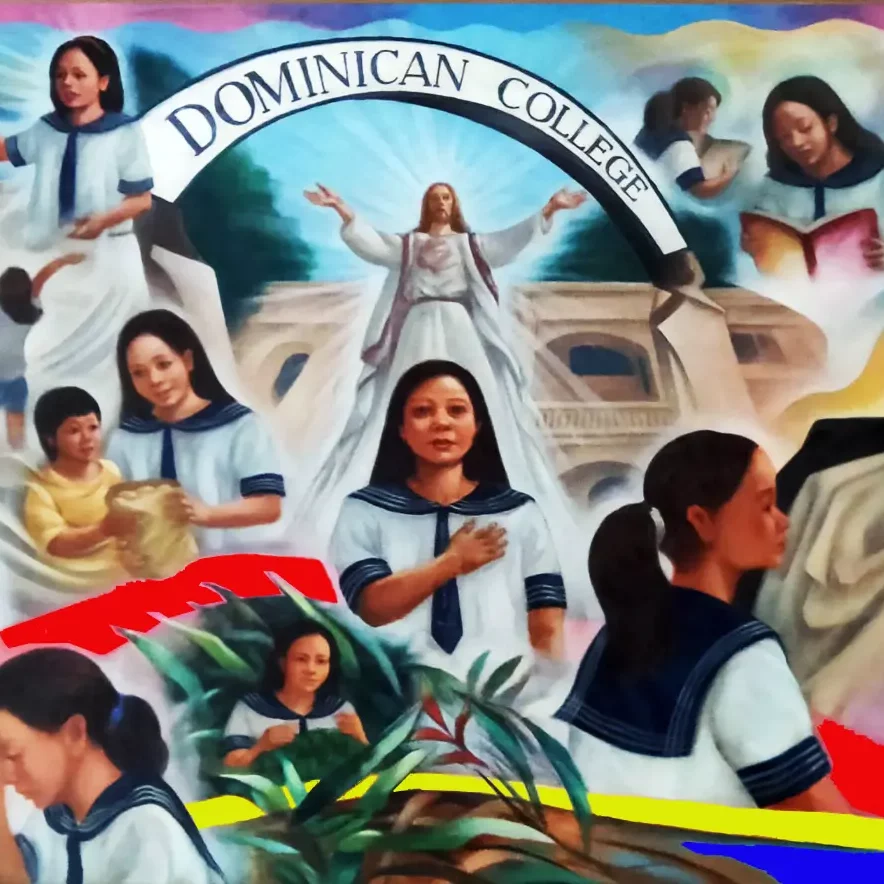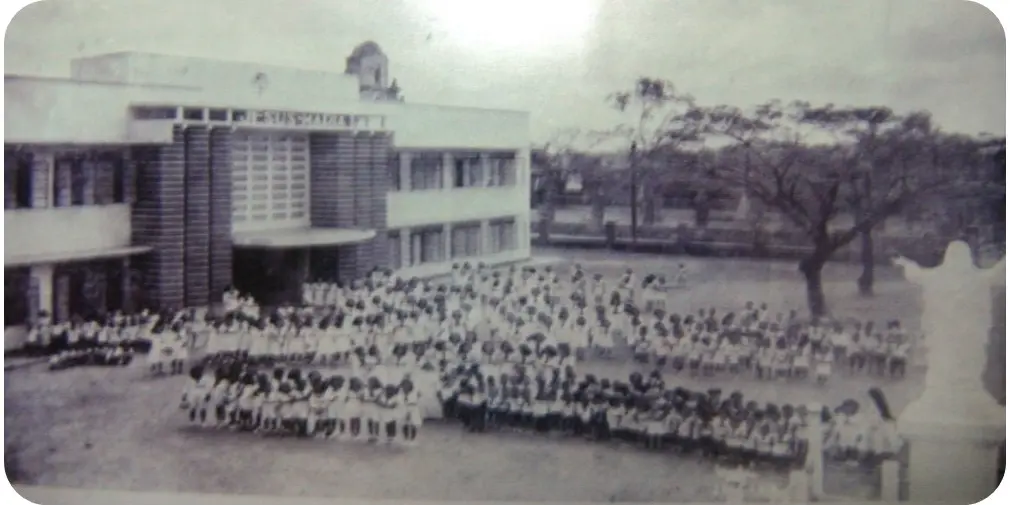About

Vision
We envision an integrated, competent, and morally upright young men and women who bear witness to the TRUTH in the service of God, country and fellowmen, especially the less privileged.
The Mission Statement
We participate in the process of social transformation by committing ourselves:
as a Filipino School
- to contribute to the preservation and enrichment of our cultural heritage, traditions, and values amidst the emerging global society.
as a Catholic School
- to nurture our Christ-like attitude and devotion to the Mother of God as we transform the result of our studies into effective instruments of social progress.
as a Dominican School
- to bring the TRUTH wherever we may be, and profess to live the Dominican spirit of STUDY, and SHARE with others the fruits of our labor.
Historical Development
Contemplare, Contemplata aliis et Tradere, Contemplate and share with others the fruits of your contemplation. This, in a nutshell, makes explicit the advocacy Dominican College as an educational institution espouses. It stresses the need for every Dominican to be not only a man of prayer but a man of study as well. Sharing with others the result of discerning the truth from his readings gives form to the true meaning of evangelization long ago started by the first Spanish Dominican Sisters who came to the Philippines in the early 1920’s. They trace their roots to the Dominican Friars of the Province of the Most Holy Rosary. After some time, this first group was split into becoming Mission Sisters for one and another into staying under the Congregation of St. Catherine of Sienna The Mission Sisters came under the fold known as the Congregation of the Religious Missionaries of St. Dominic. They were sent to various mission centers like Taiwan, Formosa, etc. while some opted to stay in the Philippines. Their electing to do mission work here in the Philippines marked a milestone in the task of evangelization with whom the missionary sisters were known for. Working as volunteer teachers in a small school run by the Dominican Friars, they became true to their word of assisting the Filipinos in the development of a strong spiritual life. Later, they were to conduct classes in the sister’s convent. These classes were catechetical in nature, at first. However, in response to requests from families in the neighborhood, the Sisters expanded the school’s curriculum for it to include Kindergarten subjects. The school became to be known as Academia de Santa Catalina until after World War II.
With the outbreak of World War II in 1941, the Academia, like all others in the country was temporarily closed. 1942 saw the opening of the new Elementary Department with the assistance of some public school teachers who offered their services for a minimum pay. This was short-lived due to the Japanese occupation of the building. It was only the American landing in Leyte that flushed out the Japanese forces from the Academia. Hopes were high that classes will soon reopen. But all hopes were in vain. The Americans also used the Academia as their military headquarters.


The war over, classes re-opened immediately ushering an enrolment boom thus necessitating the construction of a new building which materialized at the last quarter of 1947. Colegio de Jesus Maria was adopted as its new name. Enrolment was high not only in the High School Department. The same is true in the College Department. Secretarial Course was its initial offering to address the priority need of the surrounding communities for a short-term, job-incentive course. Other in-demand collegiate courses were offered too. In all the courses offered, only female applicants were accepted.
In 1966, a Congregational Statute defining the name Dominican College to be the official name of all congregational-run-schools was passed. Thus, Colegio Jesus Maria was changed to Dominican College. The school enjoyed an increase in enrolment. With this increase, the chapel had become too small for the student population. In 1969, a much bigger chapel was erected with the ground floor utilized for administrative offices. A portion was allotted as site of the Grade School Library. At present, the GS Library is housed at the good plan of St. Agnes Building used exclusively by the good, school.
With positive results as the expected output, an attempt to fuse the College Department with Aquinas School was tried in 1970 but having encountered certain inconveniences, the scheme was phased out two years after. The operation of the College Department was given solely to Dominican College Sisters. This time, the Sisters ventured for co-education as their way of extending the school’s services to the brothers of the school’s female clientele and to other young men in the nearby communities. The scheme was better accepted by client-families as proven by a favorable response to its enrolment service.
1975 onwards noted the development of the school plant to complete the facilities needed by an expanding enrolment figures. A separate college building was constructed giving way to the accommodation of Science, Computer, Mass Communications, and Food/HRM Laboratories. Canteens were made bigger and their interiors refurbished. A mini-Olympic size swimming pool became a prominent feature in the school campus, it making swimming lessons an-eagerly-awaited-activity of students in all levels. A standard size gymnasium was also constructed.
The difficult times of the post-EDSA revolution caused a slight decline in enrolment in the Basic Education Department. Schools were losing its clientele to city/municipality schools. Dominican College was not exempted in this malady that afflicted all private schools. Undaunted by this grim scenario in the elementary and high school departments, the school administration bolstered its course offerings in the College Department (1988-1989) paving the way for courses such as Bachelor of Science in Tourism, Bachelor of Science in Hotel and Restaurant Management, Bachelor of Science in Psychology, Bachelor of Science in Commerce, Major in Management, Bachelor of Science in Computer Science, Bachelor of Science in Nursing, Bachelor of Science in Physical Therapy, Bachelor of Arts in Mass Communications. With these courses, the school concretizes its contribution to the development of a Filipino, Christian, professional who is deeply imbued with the core virtues of Truth, Love and Justice. It is the school’s response to the social, economic, cultural and political needs of the Filipino society.
To strengthen the quality of education in the Basic Ed department, focusing on the continuous development of the curriculum, formation of personnel and students, and the improvement of the school’s educational services and operation, a development scheme through accreditation (by the Philippine Accrediting Association of Schools, Colleges and Universities) was made in effect. A Team of Accreditors from PAASCU conducts a preliminary, formal, or a re-survey visit. For every visit done, the team looks into the different areas like: Instruction, Faculty, Student Services, School and Community, Facilities/Physical Plant, Administration, Laboratories, Student Activity Program to ascertain whether the school’s operation is a concrete translation of the school’s mission and vision. The school has undergone three re-surveys all of which were successful.
At present the Basic Education Department enjoys PAASCU Level II accredited status. Another visit is slated on 2010 after the 2005 PAASCU Visit for the High School Level and Level II for Grade School. More challenges are expected within the five-year time frame given but surely, it will be the most opportune time through which the patience, perseverance, the hard work, dedication of all the Dominican community members would be put to a test once again. As in the past, the task has proven to be an avenue through which the spirit of cooperation, of bayanihan, is kept alive.
At this point in time, the place that Dominican College has eked in the annals of history, with its graduates filling the skies like the stars at night is a fete at par with other prestigious educational institutions. Surely, it can stand whatever political or social upheavals there might be. Come what may, the school would undoubtedly continue with its avowed mission of shepherding the young for them to become a true Catholic, Filipino, Dominican stalwarts of not only the Philippines but the global community as well. It is the institution’s share in the enhancement of man’s truthful ways, humble and just dealings with others, the underprivileged included.
